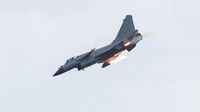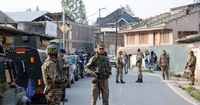In a significant escalation of military tensions in South Asia, Pakistani forces have reportedly shot down at least two Indian military aircraft using Chinese-made J-10 fighter jets. This incident, which occurred on May 7, 2025, marks a notable milestone for Beijing's advanced military technology and raises concerns about the ongoing conflict between the two nuclear-armed nations.
According to two U.S. officials speaking to Reuters, the J-10 aircraft were employed to launch air-to-air missiles that successfully brought down the Indian jets, including at least one French-made Rafale fighter. While Indian officials have refrained from confirming the loss of any aircraft, Pakistan's Defense Minister Khawaja Muhammad Asif stated that the J-10 was responsible for shooting down three Rafale planes, claiming a total of five Indian aircraft were downed in the air-to-air combat.
The situation has drawn international attention, as world powers including the United States, Russia, and China have called for calm in the region, which is considered one of the most dangerous nuclear flashpoints globally. The performance of the Chinese J-10 against Western military technology is being closely monitored, particularly for insights into potential future conflicts involving China, such as a possible showdown over Taiwan.
Following the shootdowns, blasts were reported in Jammu, Indian-administered Kashmir, during what Indian military sources suspect was a Pakistani drone attack. Pakistan has claimed to have intercepted 25 Indian drones overnight, while India asserts that its air defenses successfully thwarted Pakistani drone and missile assaults on military targets.
The use of Chinese J-10 jets in this conflict underscores the growing military collaboration between Pakistan and China. Foreign Minister Ishaq Dar confirmed to parliament that these jets played a crucial role in responding to Indian military strikes, emphasizing that Pakistan has kept Beijing informed of its military actions.
In a related context, the Indian Air Force operates a fleet of 36 Rafale F3Rs, the most advanced variant of the aircraft, which has now seen its first combat losses. A French intelligence source corroborated reports of at least one Rafale being shot down, marking a significant moment for the aircraft's operational history.
The J-10 and Rafale jets are both classified as generation 4.5 fighter aircraft, positioning them among the cutting edge of modern combat aviation. Analysts note that the engagement did not involve any cross-border incursions, with both sides engaging in a stand-off conflict at distances exceeding 100 kilometers.
Images of wreckage from the downed Rafale have surfaced, with reports indicating that it was discovered near Bathinda in India. This incident has raised questions about the effectiveness of Indian air defenses and the capabilities of the PL-15 missile, which is carried by the J-10 and has never been used in combat until now.
Military experts are analyzing the implications of this incident. The PL-15 missile is designed to reach speeds of over Mach 5 and features advanced guidance systems that significantly enhance its targeting capabilities. If confirmed that a J-10 successfully engaged and downed a Rafale, it would represent a critical demonstration of Chinese military technology in action.
In light of these developments, the geopolitical landscape in the region is shifting. Over the past few years, Pakistan has increasingly relied on China for military supplies, with approximately 82% of its arms imports between 2019 and 2023 sourced from Beijing. Conversely, India has sought to diversify its military procurement, significantly increasing its arms purchases from Western allies while reducing its dependence on Russian weaponry.
As tensions continue to escalate, both nations are under pressure to exercise restraint. China’s foreign ministry has urged both India and Pakistan to avoid a full-scale conflict, while some observers in Beijing may view the recent military success as an opportunity to further test and demonstrate their military capabilities.
The international community is closely watching these developments, as the implications of this military engagement extend beyond the immediate region. The performance of the J-10 against the Rafale could influence defense strategies and military partnerships in Asia and beyond, particularly in light of the ongoing competition between China and Western powers.
The situation remains fluid, with both nations likely to continue their military posturing in the coming days. As reports of drone attacks and air confrontations emerge, the potential for further escalation looms large, prompting calls for diplomatic efforts to de-escalate the situation.
In summary, the recent incidents involving the downing of Indian aircraft by Pakistani forces using Chinese-made jets highlight the increasing complexity of military relations in South Asia. With both nations heavily armed and engaged in a delicate balance of power, the stakes are high as they navigate this critical juncture in their historical rivalry.





